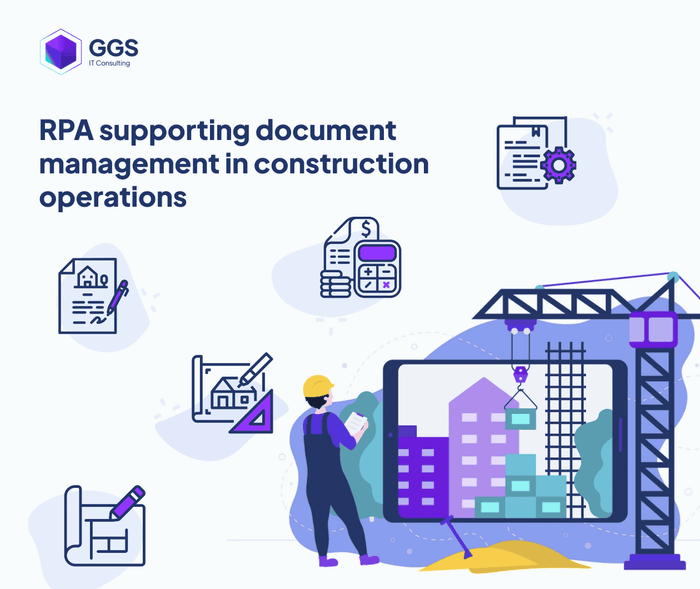Business Process AutomationLearn more
RPA supporting document management in construction operations

The construction and development industry is mainly based on manual labor related to building, with the biggest challenges associated usually with workforce shortages, health and safety concerns, and productivity issues. Changing regulations and the growing complexity of company management result in cost increase from back-office tasks. Companies have not only to assure smooth day-to-day operations but also deal with customer service management. How RPA software can help with that?
Construction and development companies have to face multiple challenges resulting from industry specifics - highly regulated and compliance-driven. We were able to identify multiple repetitive, time-consuming, and error-prone tasks related to document management, that are strong candidates for RPA implementation. This article will help you to understand the potential of RPA and its benefits for your company.
What is Robotic Process Automation and how can it be used in document management?

Robotic Process Automation (RPA) allows tasks, which used to be handled by employees for many hours, to be reduced to automated processes that take much less time. With automation carried out through dedicated software bots, programmed to perform specific tasks, employees which had to deal with repetitive, serial actions have more time to focus on more creative work.
Without the need for any software integration and complicated programming, robots help fill out records and documents, transfer data between systems, create documents, as well as be used for reporting, controlling, or ensuring data compliance.
Automation has enormous potential to improve company performance - according to McKinsey Global Institute estimations, 69% of data processing, and 64% of data-collection activities could feasibly be automated in any company.
Construction companies have to organize multiple documents, including:
- blueprints,
- drawings,
- permits,
- contracts,
- specifications,
and any other documentation related to a construction project.
When we add to that everything that is related to human resources and accounting, it creates a great opportunity for improvements with RPA.
Robotic Process Automation (RPA) software can not only be used to work on data that are already stored. By combining bots (for example UiPath) with optical character recognition (OCR), which allows converting print or handwritten text into machine-encoded text, most of the data in documents can be easily digitized, appropriately stored, and effectively used.
RPA as a part of a strategy to automate processes and workflows in a construction company
In this article, we focused on a small part of the automation strategy, which is the use of RPA software for streamlining manual and error-prone processes, which can be identified and linked to all phases of a construction project.
It’s worth noting that it would be impossible to find today a construction company that did not implement any sort of electronic document workflow. But with all the changes that are happening within the industry, it is essential to ensure that such document circulation systems still properly serve their purposes, which are most of all:
- eliminating human error from the document flow process,
- ensuring control over the document circulation processes,
- creating a central repository for documents,
- putting in order messy and unstructured processes.
Many companies have implemented an electronic document workflow without proper thought. That is why we can find even today companies that struggle with outlandish and intricate processes executed in an even more outlandish way.
To learn more about what companies should consider to assure that automation is being implemented and used in the most effective way, we invite you to read our in-depth guide on How to streamline and automate processes and workflows in your company.
If you are wondering how to start or improve the implementation of automation and digitization of processes and document flow in your company, get in touch with one of our consultants. You can book a free 30 minutes consultation with us and we will help you identify your needs and pick the right technology to match your challenges.
Use cases of document management in construction companies with RPA

As a process, document management is used to collect, track and store electronic documents, providing:
- high level of security,
- access control,
- centralized storage,
- audit trails,
- streamlined search and retrieval.
While many construction companies start to benefit from automation, according to McKinsey Global Institute, still “the construction industry is one of the least digitized industries”.
According to the FMI Big Data Report “95% of all data captured in the construction and engineering industry goes unused”, with almost 28% of UK construction companies stating that lacking the information they need on-site is the single biggest factor impacting their productivity (by JBKnowledge).
Here are a few use cases of how the construction industry can benefit from robotic process automation in document management.
Supporting document control in construction projects with RPA

As a part of document management, document control is defined as the process of capturing information in a consistent, structured way for each type of document.
Essentially this process assures that everyone with proper access is referencing the most recent versions of documents, by managing different versions of reviews, revisions, and approvals, and maintaining archives. Use of RPA might be especially useful for construction companies that are using a mix of software, including old legacy systems, newer cloud-based solutions, and sometimes spreadsheets as well.
Use of robotic process automation might include:
- ensuring proper import and storage of all document versions,
- enabling automatized digitization of all documents by combining RPA and OCR software,
- supporting routing, review, and approval process, to ensure that the document has been seen by all necessary parties,
- automating document distribution to everyone that should be included, mitigating risk or accidental exclusion,
- setting up notifications when a document is updated, reviewed, or approved.
Using a simplified example we can show how many steps and interactions are required in the construction process - and each one of those steps might be partially automated with RPA to assure faster and more accurate information exchange:
- The architect/s creates a design that is then sent to the structural, mechanical, electrical, and plumbing engineers, as well as to all contractors involved in the project.
- The engineers work together to create the projects used by contractors during the construction phase, moving through stages of:
- schematic design (SD),
- design development (DD),
- construction documents (CD).
- Drawings are submitted for permits, to ensure the plans comply with federal, state, and city standards. Once approved, plans enter the construction administration (CA) phase.
- In the process also requests for information (RFIs) are submitted by contractors, to clarify any doubts in the information provided by the engineers.
Each of those interactions can be automated, assuring that information flow is effective and all possible bottlenecks are eliminated.
RPA supporting compliance in construction projects
There are numerous interactions, data validation, and document exchange to ensure compliance with not only regulatory requirements but also other companies and inspectors that have to approve projects.
Construction company’s employees, managers, or contractors acting on behalf of the company have to ensure that all requirements will be met, by interacting with:
- government agencies,
- notaries,
- the land registry,
- the cadastre,
- utility companies,
- public inspectors.
While RPA software can support employees with communication, notifications about deadlines, assuring version control to submit correct documents, and help with quick finding and gathering the right information, it is also worth having in mind that many government agencies and local municipalities are embracing digitization as well, which includes using Automated Building Plan Approval Systems.
This trend will surely increase, as time savings and effectiveness improvement with the successful implementation of ABPAS class software are huge. As an example we can look at achieved efficiency improvement for Urban Administration and Development Department in India:

Source: www.onlineasdma.assam.gov.in
Especially for larger companies, working in many countries and having to comply with various regulations, using an automated system is essential.
Better audit readiness with robotic process automation
Each construction project will be undergoing multiple audits, both internal and external. Finding and preparing necessary documents for auditors is time-consuming and can be partially automated, especially in the case of repetitive and frequent audits.
An example of such improvement with automation was described in an article at College and University Auditor Journal, describing how construction companies gather data with GPS tracking that enable them to track the exact location of heavy equipment, operating hours, consumables, and environmental conditions. Such data can be used by construction audits, for example allowing to check if quantities billed for dirt hauling, aggregate purchases, and heavy equipment rental are representative of actual activity.
To verify that, the auditor could gather and compare information such as:
- number of dump trucks that were on site,
- trips each truck made,
- weight of the product hauled,
- time spent loading and unloading.
With that data, the auditor can calculate cubic yards moved from the site to reconcile the trucking bill. And with properly set up RPA software such reports can be created automatically at any given time, with alerts added in case any of the metrics would exceed predefined values.
RPA in document management as a step for digital transformation
From our experience, implementing robotic process automation software is often the first step for the full digital transformation of a company. When done correctly, it can have a huge impact on the overall effectiveness of operations.
The main benefits of using business processes automation reported by our Clients are:
- saving employees' time - with automation of repetitive tasks, employees will no longer devote time to ineffective work,
- cost reduction - properly implemented business processes automation can reduce costs by 25 - 60 %,
- productivity increases - as processes work faster and their effectiveness can be accurately measured,
- error reduction - especially when monotonous, error-prone tasks are automated,
- increased employee satisfaction - reduction of mundane and repetitive tasks has a direct and immediate influence on employees' satisfaction.
Creating a proper implementation strategy and executing it can be challenging. Very often, automation of business processes integrates various technologies, concepts, and approaches. When implementing digital transformation, it's worth looking for a partner who takes a broad view of it and is able to link a deep understanding of business with technologies that help make changes in the company.
If you would like to know how to approach the optimization of business processes in your company contact us and arrange 30 minutes, free consultation. We will help you to assess which technologies will bring the greatest benefits in the area of automation and standardization of processes in your company.

